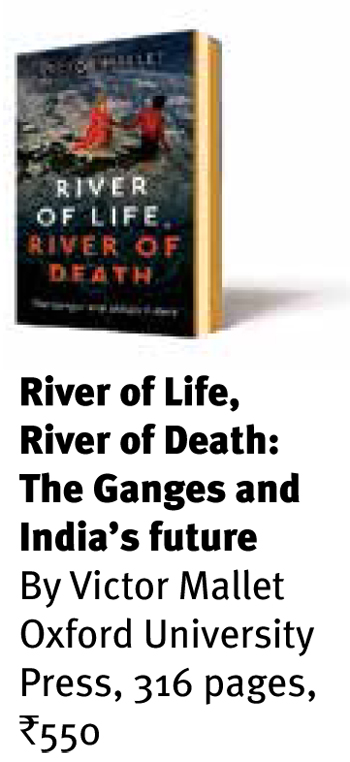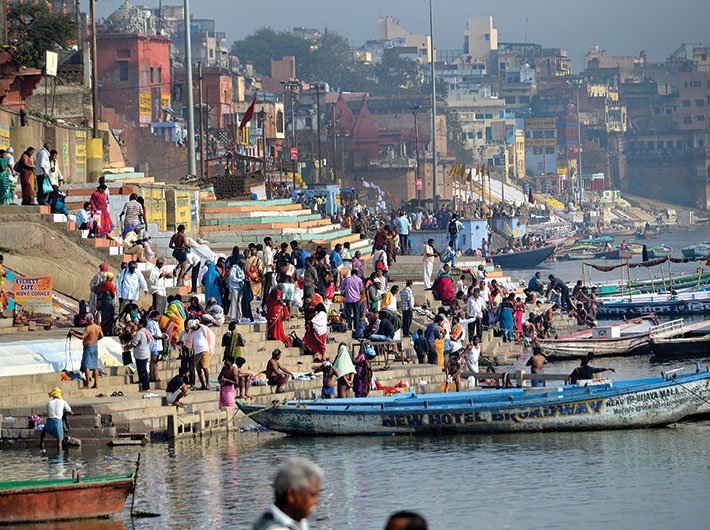If water had memory, the Ganga would tell a story that begins in pure joy in the Himalayas and ends in the tragedy of pollution. It would remind us of its simple and holy beginnings in the hills, irrigating innumerable farms in the plains, being the source of food and livelihood to millions. It would not only remind us of the 43.78 crore people living on its banks, but also of the biodiversity it sustains within itself. It would tell us about art, culture, music, rituals, festivals and food habits across the rich Gangetic belt, where, at some places, 100 ml of water contains up to three lakh coliform bacteria!

Author Victor Mallet, a senior journalist with the Financial Times who was based in Delhi from 2012 to 2016, has tried to decipher the Ganga’s soliloquy and presented it over 300 pages of journalistic writing. He begins with an introduction meant largely for an international audience. Right from the very basics, he builds a picture of the Ganga with all its mythological and historical connections. There is, of course, a spiritual aspect to the Ganga: the river is sacred to Hindus, and is a part of many of their rituals. As a result, there is political significance too, especially in the time of Hindutva. Most important, however, is how the river – the holiest of holy rivers though it be – is being polluted, turning into a flowing environmental hazard.
He narrates how Capt JA Hodgson, a soldier-surveyor of the British army, reached Gaumukh, the source of the Ganga in 1817, and saluted the river with a bugle march. Of his own visit, Mallet writes: “We had no bugle to salute the Ganges, so I merely admired the glacier – a fractured cliff face of opaque blue, mixed with dirt and chunks of rock – and peered cautiously into the cave at its base from which gushed the beginnings of the river.” He speaks of the flash-floods of 2013, the floods of 1978 and the 1991 earthquake. Through his interactions with the locals of Uttarakhand, he tells us how climate change is affecting birds, animals, river and humans equally. In other chapters, he is reporting from prominent cities on the banks of Ganga in the other four states the river passes through – Uttar Pradesh, Bihar, Jharkhand and West Bengal – that bear the brunt of Ganga pollution. He devotes a full chapter to the Kumbh Mela of 2013 which was held at Sangam in Allahabad.
In later chapters, he focusses on Varanasi, a famous Hindu pilgrimage centre and the Lok Sabha constituency of prime minister Narendra Modi. Mallet writes how Varanasi attracted all the limelight for a day in 2014 when PM Modi filed his nomination from the city and vowed to save Ganga. In 2016, Mallet visits Varanasi only to find out several broken promises and a dirty Ganga. “Now Modi’s sitting there and has painted these buildings, but what else has changed? People here, they shit, they crap, and piss and who can tell them to stop?” he quotes a boatman as saying.
The book becomes gripping in the pages where the plight of the river is being discussed based on facts and reports and not faith. The chapters ‘Superbug River’ and ‘Toxic River’ are most informative. These deal with industrial toxins and waste from tanneries entering the Ganga, antibiotic-resistant diseases and their proliferation in the river. “Even if there is some bacteria killing property in Ganges water, it is clearly not 100 percent effective, and it may be the result of the river’s ability to rapidly re-oxygenate itself, or of magnesium or sulphur or something in the silica-rich salt carried down from the Himalayas rather than the bacteriophages that exists in all rivers and seas... True, there are a lot of bacteriophages in the Ganges, but, as Felix d’Herelle quickly learned, bacteriaophages are found wherever bacteria thrive: in sewers, in rivers that catch waste runoff from pipes, and in the stool of convalescent patients,” he writes. D’Herelle was a Canadian scientist who, in 1916-17, wrote of the bacteria-killing properties of Ganga water, and his findings were cited by those who believe Ganga water has curative properties.
The book has 20 pictures showing the Gangotri glacier, Sundarbans, the 2013 floods in Uttarakhand, Kumbh Mela of Sangam, Ganga Sagar, polluted Yamuna river and old paintings and lithographs which make the reading even more engaging. In later chapters, he discusses flora and fauna in the chapter ‘Dolphins, Crocodiles, and Tigers’. He also devotes another chapter to the growing water crisis in the Gangetic belt due to the depletion of ground water. Mallet writes of his visit to the drought-hit Bundelkhand region (towards the south of Gangetic plains) in 2016. In the same chapter, he goes on to describe the Munak Canal breach, water crisis in Haryana and Punjab and even Delhi. He also touches upon the irony of the floods, flash floods, water logging, etc. The unplanned usage of water and lack of a proper water management is the focus of this particular chapter. “More than 60 per cent of India’s irrigated agriculture, and 85 per cent of its drinking water, depend on this groundwater... Government data, already more than five years out of date, show that 839 of India’s 5,723 administrative blocks were suffering from over-exploited groundwater in 2011,” he writes.
In the following chapters, Mallet has discussed river engineering at length. While in one chapter, he has written a great deal about river engineering, and hydropower projects in the upper stretches, in another one he is commenting on the sandbanks and river hydraulics in the plains. Mallet illustrates how the Ganga was a prominent means of transportation before the arrival of railways and development of roads. Giving anecdotes of Lord Hastings’ voyage downstream in around 1814, Mallet describes that even during that time, navigating the river was a complex and labourious as ships and boats repeatedly ran aground. He also comments on the Modi government’s ambitious inland waterways push when the author’s ship journeying in the Hoogly river north of Kolkata ran aground for the water was too shallow. “It was furthermore, mid-February, before the worst of the hot, dry season ahead of the monsoon, and there should still have been enough water in the river for a flat bottomed, shallow-draft tourist vessel such as ours to proceed to unhindered,” he writes.
Towards the end of the book, he writes how and why it is difficult to clean up the Ganga, and how private agencies are helping. He draws parallels to the cleaning projects of the Rhine and the Thames. However, he believes that despite the necessity to clean up the river, the sense of urgency is missing among the people as well as the government. The last chapter on the Sundarbans and the flora and fauna of the place is a mesmerising account of the river meeting the Bay of Bengal. Overall, the book is a beautiful voyage on the river, a journey that is full of painful and happy moments and a staring towards a sad future.
swati@governancenow.com
(The article appears in January 15, 2018 edition)

